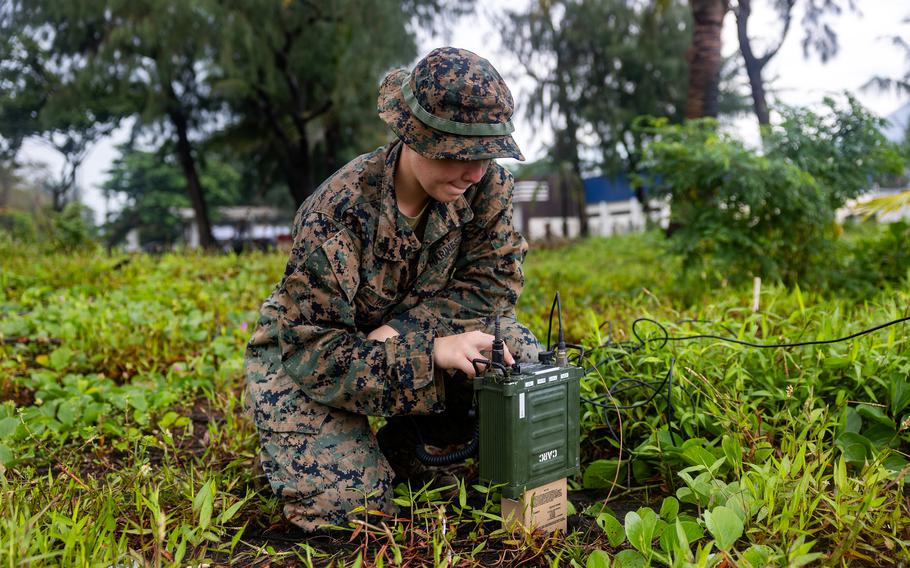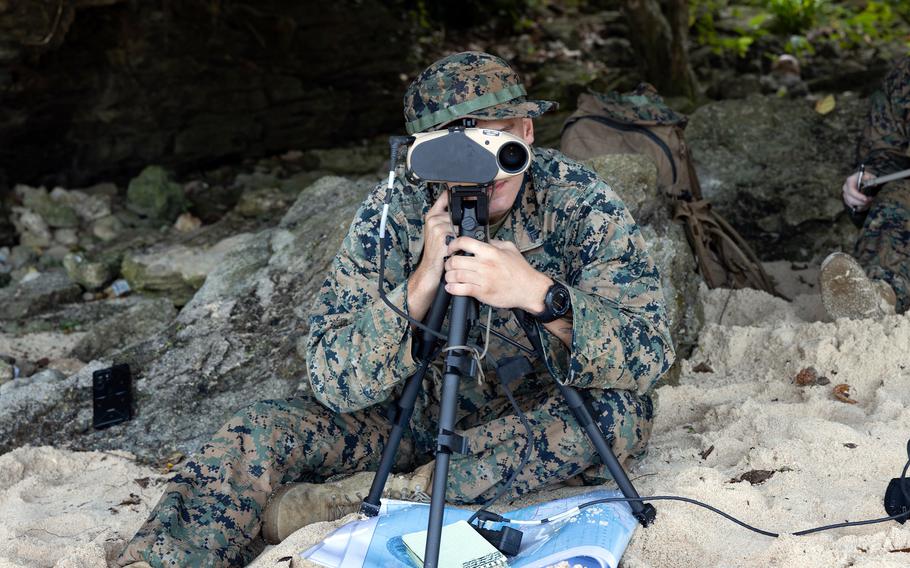
Cpl. Eniya Yanina of Marine Rotational Force-Southeast Asia uses a high frequency radio at Naval Station Julhasan Arasain in Legazpi, Philippines, Oct. 11, 2023. (Ryan Pulliam/U.S. Marine Corps)
MANILA — A contingent of Marines from a relatively new rotational force will lead U.S. forces during multinational coastal defense drills starting Thursday in the Philippines, according to the unit’s commander.
Kamandag, which runs through Nov. 20, will involve 2,000 troops training on the main island of Luzon and to the west on Palawan, according to an announcement by the year-old Marine Rotational Force – Southeast Asia on Sunday.
“MRF-SEA only participated in this exercise last year, and now we are privileged to be leading all U.S. Marine forces in this year’s exercise,” force commander Col. Thomas Siverts said in the statement. “We’re able to capitalize on relationships established a year ago. We’re leading and improving interoperability alongside the very same Philippine Marine Corps counterparts.”
The military uses the term interoperability to describe the ability of a country’s armed forces to use another’s training methods and military equipment.
The exercise takes place during a period of increased tension between Manila and Beijing in the South China Sea. Chinese coast guard and maritime militia in the past months have tried unsuccessfully to block Philippine vessels resupplying a marine territorial outpost at Second Thomas Shoal, a disputed reef in the South China Sea.
In the most recent incident, a Philippine supply vessel collided Oct. 22 with a Chinese coast guard vessel attempting to block it from reaching the outpost west of Palawan.
A major clash in the South China Sea, which Beijing claims as its territory, could potentially involve U.S. forces. Washington has vowed to defend Manila, a treaty ally, if it is attacked.
‘Cohesive’ forces
In Manila on Oct. 27, Maj. Michael Racicot, fires and effects coordinator for the rotational force, told Stars and Stripes that 200 Marines from the new unit will participate in Kamandag.
Some have been working out of Fort Bonafacio, the Philippine army’s headquarters near the capital, he said.
Troops from Japan and South Korea, along with observers from the United Kingdom, will also train during the exercise, according to the rotational force statement.
Marine Rotational Force – Southeast Asia and Marine Rotational Force Darwin, which has operated out of northern Australia since 2012, fall under the Camp Pendleton, Calif.-based 1st Marine Expeditionary Force.
The Darwin force, which wrapped up its latest six-month rotation Oct. 1, began with about 250 Marines and reached full strength at 2,500 Marines in 2019.
“MRF-D and MRF-SEA are meant to be complementary to each other,” Racicot said.
The Southeast Asia rotation of 200 Marines is a “cohesive inside force” that can provide specialists such as air naval gunfire liaisons, engineers and explosive ordnance disposal Marines, he said.

Cpl. Hunter Way of Marine Rotational Force-Southeast Asia searches for vessels of interest in Sorsogon, Philippines, Oct. 9, 2023. (Kai Huber/U.S. Marine Corps)
Permanent presence?
The force’s appearance in the Philippines comes as the country makes more sites available to U.S. forces under the 2014 Enhanced Defense Cooperation Agreement.
However, the new rotational force Marines have yet to train at the new sites in the Philippines made available under the 2014 agreement, Racicot said.
“I can’t speak to what the future is going to look like,” he said, but “it keeps us forward in Southeast Asia.”
There’s no reason why the new rotational force can’t have a permanent presence in the region, including on the newly available Philippine bases, according to Grant Newsham, a retired Marine colonel and senior researcher with the Japan Forum for Strategic Studies in Tokyo.
“It’s better to have a constant presence,” he said in an email Thursday. “Shows you care and also creates a very different sort of relationship with local partners - who get tired of seeing new faces every time the Marines show up.”
The Southeast Asia force could grow to battalion size — about 600 Marines — equipped with helicopters, on top of a smaller, permanent party in country, Newsham said.
After Kamandag, 150 Marines from the rotational force will head to Indonesia to train during the Keris Marine exercise between late November and early December, Racicot said.